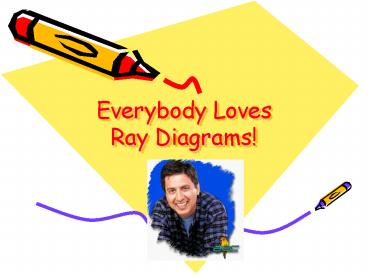Everybody Loves Ray Diagrams - PowerPoint PPT Presentation
1 / 17
Title:
Everybody Loves Ray Diagrams
Description:
Center of curvature: The point in the center of sphere from which ... Process for Concave RDs. Pick a point on the top of the object and draw two incident rays. ... – PowerPoint PPT presentation
Number of Views:633
Avg rating:3.0/5.0
Title: Everybody Loves Ray Diagrams
1
Everybody Loves Ray Diagrams!
2
Why Ray, Why?
- We draw ray diagrams to determine
- Location
- Size
- Orientation
- Type
- of images formed by a concave or convex (think
curved) mirror.
3
Key Terms!
- Center of curvature The point in the center of
sphere from which a curved mirror was sliced. - Principal Axis The line passing through the
center of the sphere, attached to the mirror in
the exact center. - Vertex The geometric center of the mirror.
- Focal Point Midway between the vertex and the
center of curvature. Its also the point at which
light traveling parallel to the principal axis
will meet after reflection.
4
Picture, Please!
Vertex
Focal Point
Center of Curvature
5
Rules for Concave Mirrors
- Any incident ray traveling parallel to the
principal axis on the way to the mirror will pass
through the focal point when its reflected. - Any incident ray passing through the focal point
on the way to the mirror will travel parallel to
the principal axis when its reflected.
6
Ok, Pictures Quickly!
Rays are parallel to the principal axis on the
way in, so they go through the focal point when
reflected.
Rays go through the focal point on the way in, so
they are parallel to the principal axis when
reflected.
7
This is How We See!
- But dont worry well start with simplified
drawings!
8
Process for Concave RDs
- Pick a point on the top of the object and draw
two incident rays. - Draw one ray passing through the focal point
- Draw the second parallel to the principal axis.
9
Keep Going
- Reflect the IRs so the ray passing through the
focal point reflects parallel to the principal
axis. - Reflect the ray which traveled parallel to the
principal back through the focal point.
10
Almost Done!
- Mark the image of the top of the object.
- Repeat the process for the bottom of the
object. - Draw a line from the top of the image to
principal axis. (the bottom of the reflected
image will always fall on the principal axis)
11
So Lets Recap!
- The image depends on the distance of the object
from the mirror. - You have these choices
- Outside the center of curvature (C)
- At the center of curvature (C)
- Between the center of curvature (C) and the
focus (F) - Between the focus (F) and the mirror (this
ones a bit different, so be patient)
12
Outside the center of curvature (C)
13
At the center of curvature (C)
14
Between center of curvature (C) and the focus (F)
15
So Why Did We Do This?
- In these three cases 1) object located beyond C,
2) object located at C,and 3) object located
between C and F - light rays converge to a point
after reflecting off the mirror. In such cases, a
real image is formed. - A real image is formed whenever reflected light
passes through the image location. Unlike plane
mirrors which always produce virtual images,
concave mirrors can produce real and virtual
images! (Cool, huh?)
16
When do Concave Mirrors Make Virtual Images?
- A virtual image is formed if the object is
located less than one focal length from the
concave mirror. - Take a look!
17
Between the focus (F) and the mirror































